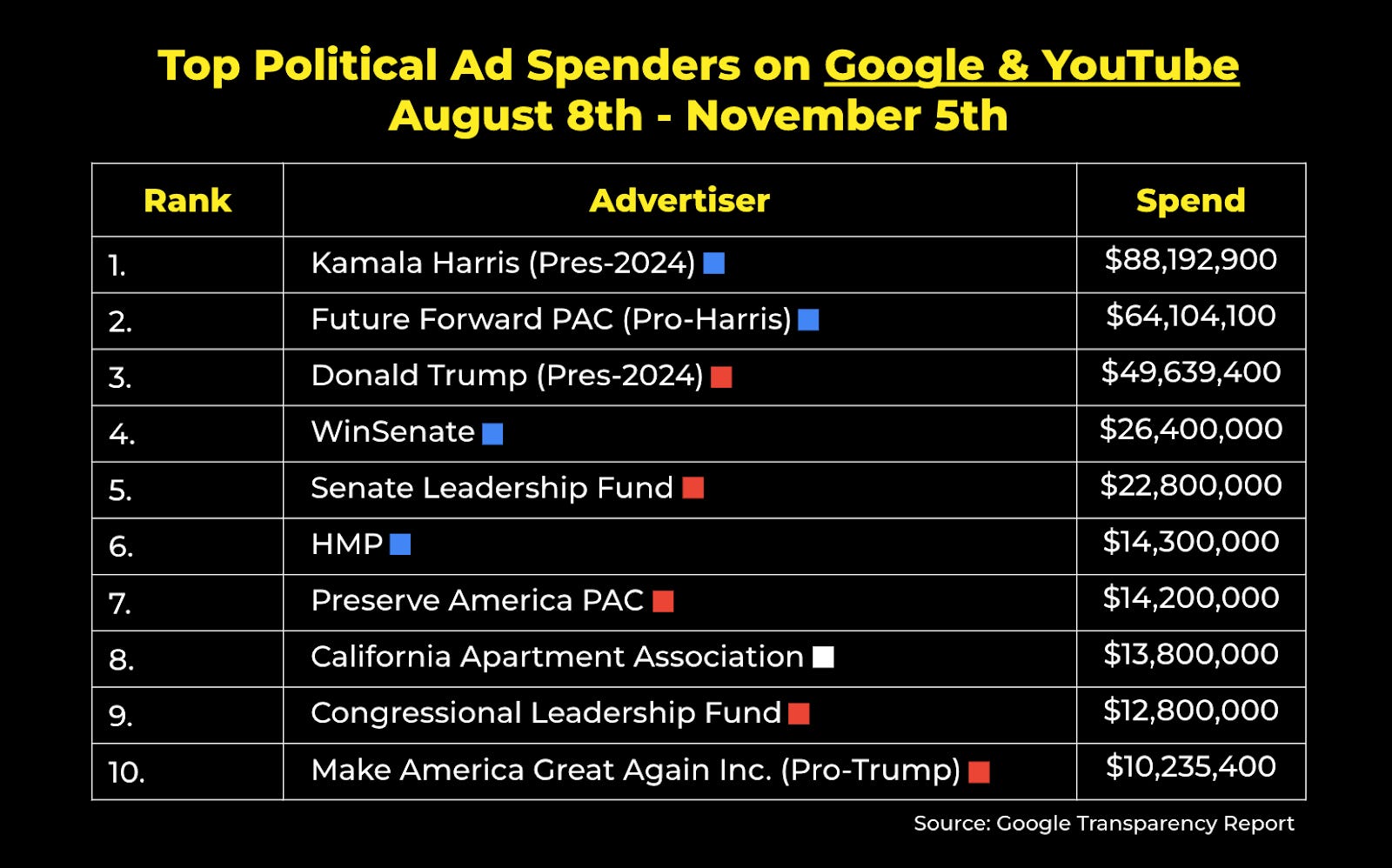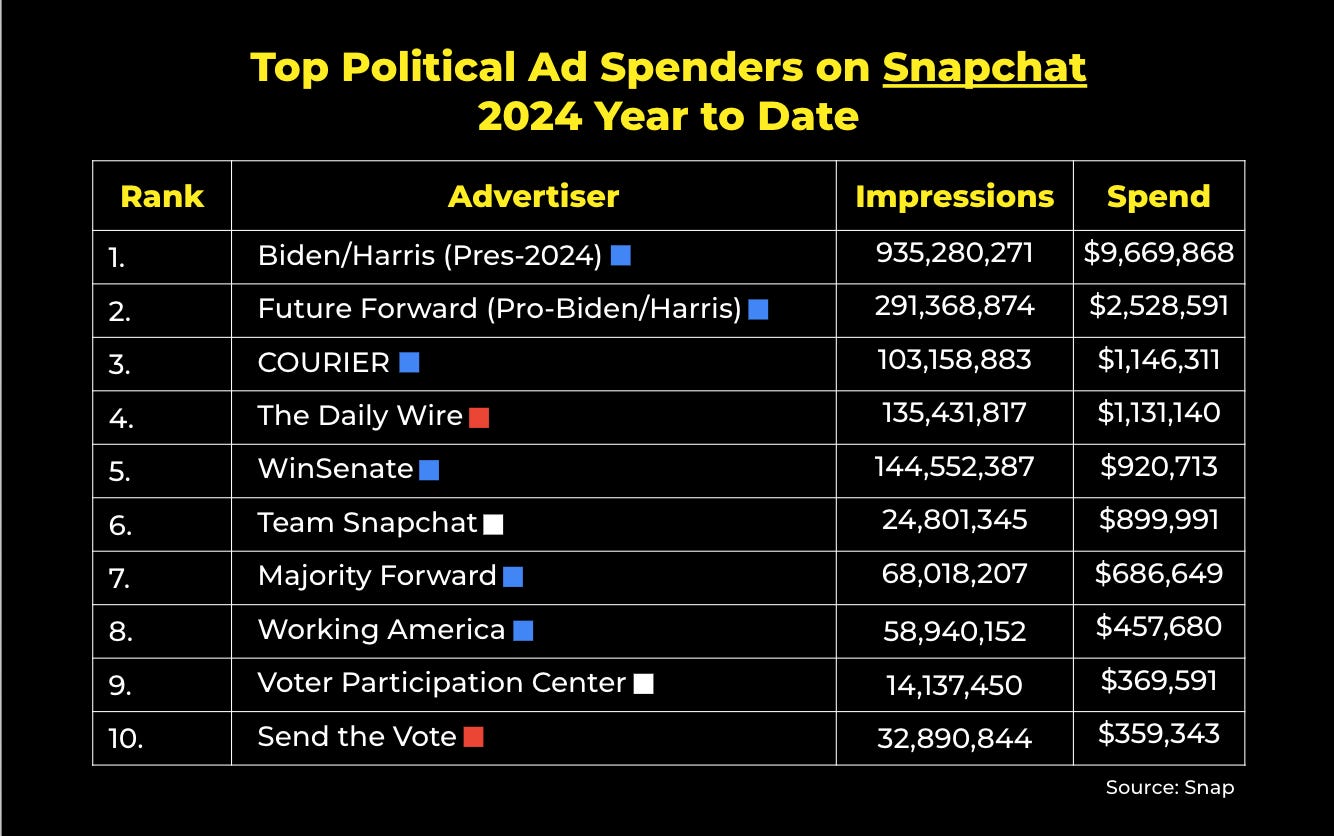👋 Welcome to FWIW, the leading newsletter tracking digital spending, strategy, and trends in our elections. We’re glad you’re here. The post-election fog of warInside: Liberals leave X for bluer skies, the DNC chair race begins, evidence that campaigns matter, and more…Happy Friday, it’s been quite a week. In this week’s issue, we’ll share final digital spending data from the last 3 months of the campaign, plus a few interesting examples of how Democrats are starting to sort through the post-election fog of war. Let’s dig in. Digital ad spending, by the numbers:FWIW, U.S. political advertisers spent $628.5 million on Google and YouTube ads during the final three months of the election (Aug 8 – Nov 5). Here were the top ten spenders nationwide: As expected, the Harris campaign was the top political advertiser on Google and YouTube ads in the final stretch of the election, spending nearly $90 million on the company’s platforms in a 90 day period. The majority of their Harris for President ads during this timeframe targeted the following states in this order: Pennsylvania and Michigan (tied at $12.2 million spent), and then Georgia at $6.4 million spent. Unlike 2020, Democrats put all of their eggs in one basket this cycle in terms of presidential Super PAC spending - with Future Forward tasked with providing Harris with hundreds of millions of dollars worth of air cover. The low-profile PAC spent around $64 million on Google and YouTube in the campaign’s final stretch, mostly pushing pro-Harris economy and reproductive rights messaging to all seven battleground states. Although they were dramatically outspent by the Harris campaign all cycle, Team Trump did spend a significant sum on digital ads in the campaign’s closing days. Their Google + YouTube ads focused on linking VP Harris to President Biden, especially when it came to his perceived economic failures (and also a notable amount of Trump’s ads were focused on fundraising for the campaign). Team Trump largely targeted states like Pennsylvania, Georgia, and North Carolina. All of the other top advertisers on Google were pretty predictable: congressional outside groups like WinSenate for the Democrats and Senate Leadership Fund for the Republicans. Meanwhile, political advertisers spent just over $522 million on Facebook and Instagram ads over the last 90 days (Aug 8 – Nov 5). These were the top ten spenders nationwide: On Facebook and Instagram, liberals flooded the zone. The Harris campaign spent a wild amount of money (over $100 million!) through 19 different Facebook pages, and progressive media outlets like NowThis spent large sums promoting their original content through various brands. Aside from the Trump campaign, right-wing media company The Daily Wire also dropped a huge amount of money on the platform promoting its own products. On X (formerly Twitter), political advertisers in the U.S. spent around $22.9 million on ads year to date. While that’s far below the company’s initial target for $100 million in political ad sales this year, it’s a large amount of money for a platform that had banned political ads until last year. According to X’s political ad disclosure, here are the top spenders year to date: The deceptively-named right-wing RBG PAC (which was created in late October to try and help Donald Trump win over pro-choice voters) zoomed to #2 on the X/Twitter political ad charts at the very end of the campaign. They specifically ran waves of ads that stated that Trump does not support a national abortion ban. …and lastly, on Snapchat, political advertisers in the U.S. have spent $27.2 million on ads year to date. Here are the top spenders: Snapchat political ads remained a pretty heavily Democratic space through the end of the cycle – the Trump campaign notably only spent $61,924 on the platform in 2024, compared to the Biden/Harris campaign’s spend of just under $10 million. Presidential head-to-headFWIW, here’s how weekly digital ad spending (Facebook/Instagram, Google/YouTube) compares between the Trump and Harris (formerly Biden) campaigns year-to-date: This chart shows the Trump and Harris campaigns’ spending from January 1st to November 9th. Overall, both campaigns largely slowed and then stopped spending on ads immediately after Election Day – the spike you see from the Trump campaign came from a massive Google + YouTube ad spend of $11 million from them in the very last days of the campaign. Is Bluesky going to be a thing now?This week, it seemed like every way-too-online coastal elite with an opinion of Elon Musk decided to join Bluesky, a rival platform to X. I’ve spoken with a handful of progressive X users this week who have lost thousands of followers on the platform since Election Day. I also know of quite a few people who abandoned Elon’s toxic site in favor of Bluesky, using the hashtag #eXit. A few technology writers I respect - Casey Newton, Ryan Broderick, and Taylor Lorenz - wrote about the movement to Bluesky and whether they think it will have legs. You should read their takes, and let me know what you think in the comments. Evidence that campaigns matter?Despite all the takes you may have read, we have shockingly little certainty about what exactly had a real impact on last week’s result. Most of the post-election analysis has been derived from exit polls, which are messy and may not accurately capture what happened in key states. As everyone continues to look at these exit polls and whatever else, I found these two charts really interesting, cited as potential evidence of how campaigns can impact voters. The TL;DR is: in places where the campaigns targeted voters with millions of dollars of ads and organizing efforts, voter turnout was higher, and there was generally less of a shift from 2020. Take a look: The DNC chair fight beginsOne of the most visible fights for the future of the Democratic Party is about to kick into gear: the race for DNC Chair. Sometime in the next few months, members of the Democratic National Committee will convene to elect a new party chair - a high-profile role that will help set the initial tone for how Democrats start to message against the new Trump administration. While important, the DNC is not the cigar-filled, powerful backroom that many outside of DC think it is. Instead, the committee basically just serves two core (and very online) purposes - year-round fundraising and maintaining the party’s data & technology operation. Current names I’ve seen or heard floated include state party chairs Ben Wikler and Ken Martin, grassroots favorite Sen. Adam Schiff, former Obama brawler Rahm Emanuel, and NJ Gov. Phil Murphy, among others. I don’t think any of these people would inspire droves of Democrats to get excited about the future of the party, but several of them - like Schiff and Wikler - understand how the internet works and have proven themselves capable of raising loads of money. We’ve had a string of okay but less-than-exciting party chairs in recent years - Jaime Harrison, Tom Perez, Debbie Wasserman Shultz, Tim Kaine - so many people’s expectations are pretty low at the moment. More from around the internet:
That’s it for FWIW this week. This email was sent to 24,262 readers.If you enjoy reading this newsletter each week, would you mind sharing it on Twitter or Threads? Have a tip, idea, or feedback? Reply directly to this email. |







